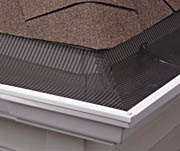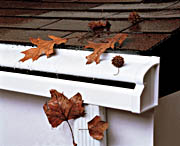Clean Up With Gutter Protection

Homeowners don’t like to clean their gutters because it is dangerous, expensive and dirty. According to the U.S. Consumer Products Safety Commission, 20,000 accidents occur each year while people are using ladders to clean gutters. Most of these accidents result in bumps and bruises, but some cause permanent injuries or are fatal.
Homeowners who don’t clean their own gutters must pay between $75 to $150 for someone else to do the job. If their gutters are cleaned only twice yearly (which is not enough in many areas), the homeowner has spent $750 to $1,500 in five years and is responsible for any accidents that may occur in the process. For about the same amount of money, these homeowners could have gutter protection installed and never again worry about cleaning their gutters. Installing gutter protection not only saves homeowners money, but is also quite profitable for roofing contractors.

Types of Protection
Basically, there are four different types of gutter protection systems. Some simply fit over existing gutters and are quite easy to install. Others are entire systems that replace the existing gutters.The first type of protection consists of gutter guards and covers. These devices work by a process known as surface adhesion, which lets rainwater into the gutter but keeps most leaves and debris out. Examples of these systems include Gutter Topper, Gutter ProTech and LeafGuard.
“Gutter ProTech can be added to existing gutters, which means customers do not need to purchase new gutters if their existing gutters are in good shape,” states Charles Knight, president of Absolute Gutter Protection, manufacturer of Gutter ProTech. “The roof package is not penetrated with nails or screws at any time during the installation of our product, so the roof warranty is not jeopardized.”
Gutter ProTech has two rows of offset louvers that prevent large leaves or other debris from being drawn into the gutter along with the rain. The openings are large enough to capture the heaviest rain while still rejecting anything that would not wash right on through the downspout. Each time it rains, the louvers draw the rain in and wash the inside of the gutters making them virtually self-cleaning. Gutter ProTech panels are made of the same quality aluminum coil stock as most seamless gutters and are also available in copper.
Gutter Topper is engineered to be installed over existing gutters. It has a patented clip-on system that eliminates the need for brackets. The system’s design includes an ice-release system that also protects gutters from leaves, debris, pine needles, bird nests and squirrels. Gutter Topper is manufactured out of 0.024 aluminum to provide sturdy and durable construction, and its low profile preserves a home’s “curb appeal.” The product has a 20-year transferable material warranty and a transferable lifetime performance warranty.
LeafGuard is a one-piece system rollformed to seamless custom lengths at the job site. The gutters, approximately 20 percent thicker than conventional gutters, are attached to the fascia board of the house and not to the roof itself, so the integrity of the roof is never compromised. LeafGuard is painted with a Castle Clad finish, which comes with a 20-year limited finish warranty.
A second type of gutter protection includes the various screens, ranging from sophisticated plastic to metal. “Leafscreener is a 9-inch-wide mesh constructed of industrial strength UV-resistant Polyethylene coated with carbon to prevent leaves from sticking,” explains Paul W. Sack of Leafscreener. “The L-shaped trim is made of 0.032 gauge aluminum. Each trim piece is 1/2 inch by 3/4 inch by 5 inches, and is available in a variety of colors. We also offer a 10-year material and performance warranty.”
Steelco Rigid Gutter Screens are another type of screen. This product can be installed on top of shingles or under, with special clips. A standard section measures 5 inches by 36 inches, but it also comes in 6- and 7-inch widths. This rigid screen is available in galvanized, aluminum and copper.
A slightly different take on this concept comes from DCI Products, Clifton Heights, Pa. The Flo-Free™ is a gutter insert that fits new or existing gutters. Constructed of 3/4-inch, 100-percent nylon, it fits snuggly into any K-style gutter, completely sealing the systems from debris and snow build-up. The product is not visible from the ground and is guaranteed for life.
The third type of system enables homeowners to thoroughly clean their gutters by merely unlatching a few hooks. “With Tilt ‘N Clean homeowners don’t need a ladder,” says Kevin Leahy, President of Tilt ‘N Clean Rain Gutter Systems. “Standing on the ground, homeowners use a specially designed pole to tilt their gutters forward from the water-catching position and lock them in the cleaning position, spilling out debris. Homeowners can safely perform all gutter-cleaning tasks without leaving the ground.”
Tilt ‘N Clean is a complete rain gutter system that replaces the existing gutters. It features a slotted support bracket and gutter hook that allow the whole gutter to rotate and lock in a water-catching position or in a cleaning position.
The final type of system is actually a “gutterless” system called Rainhandler. Instead of a trough to catch the water and everything else that falls in, this system has angled louvers — similar to a venetian blind — that break up sheets of roof rain into tiny droplets. The droplets are then gently diverted to the ground in a swath 2 to 4 feet wide. They fall on the plants and lawn surrounding the home but away from the foundation. When leaves and debris hit the system, they fall through or blow away. If debris does get lodged in the louvers, it can be easily flushed out from the ground with a garden hose.
Additional Revenue
“Gutter protection is an easy sell,” says Peter Davidson, a partner in Blackhawk Home Improvement Inc., based in Chicago. “When you replace a roof, probably 70 percent of the time you should replace the gutters. After all, we don’t just install the roof, we do a roofing system. And the same goes for gutters. When we install gutter protection with the gutters we install a complete gutter system. So as you add to your ticket and do a complete roofing system by adding gutters, you can enhance it even more by putting on gutter protection.”Davidson points out that, “Installing gutter protection boosts the average ticket up quite a bit. Plus, it requires no additional equipment or staff. It may add a couple hours to the installation of the gutter, but the additional revenue more than makes up for the extra time.”
According to Knight, installing a product like Gutter ProTech can add an extra $1,000 to $1,500 profit for a job that can usually be completed in less than one day from start to finish. To reduce installation time and increase profits, Knight recommends having one or two workers do the installations on all jobs rather than having different people installing each time.
“Past customers are an easy sell, but the perfect time to install gutter protection is when a new roof is being installed,” says Knight. “Two requirements for installing Gutter ProTech and most types of gutter protection on a customer’s home are that their roof and gutters must be in good condition or be replaced.”
Del W. Henry, general manager at Steele Plastics Mfg. Co., manufacturer of the Steelco Rigid Gutter Screen, says, “Installing gutter protection is a fast and easy way for roofing contractors to generate additional revenue from each job. I can install 200 feet of our product on a home in less than an hour.”
Selling Gutter Protection
“If a customer has just spent several thousand dollars for a new roof, what is another few hundred dollars to have their gutters cleaned and a screen put on while the roofing contractor is already there?” asks Henry. He then points out that most homeowners can see their roofs, but not inside their gutters. Unless the homeowner has actually gotten up on a ladder and looked into their gutters, they are not aware of the condition inside there.“The roofing contractor must bring the condition of the gutters to the homeowner’s attention with a comment like, ‘While we were on your roof we noticed that your gutters have a lot of leaves and other debris in them. You should have some type of protective device on them. After we finish your roof, we can clean your gutters and install a screen for you.’ The roofing contractor can easily include the cost of having the gutter protection installed along with the roof job,” explains Henry.
Steve Pedi, a principle with R. Eck and Son, based in Forest Park, Ill., general contractors specializing in roofing and gutter systems, says that, “Homeowners who pay to have their gutters cleaned a couple times a year can recoup their investment for a gutter protection system in just a few years. If they don’t clean out their gutters as often as they should they can face problems from water damage. They also face liability issues every time someone gets up on their roof to clean their gutters. So, gutter protection definitely pays for itself and most homeowners are quick to see this.”
Knight advises that a roofing contractor’s salespeople be knowledgeable about the benefits of gutter protection so they can sell the benefits rather than discount the product. “Sell the benefits and you will be amazed at the profits gutter protection will generate for you,” states Knight.
Without a doubt, gutter protection is a valuable product and most homeowners would gladly pay a roofing contractor to install it. But there are so many different types and brands of gutter protection. Which system should a roofing contractor choose?
Knight suggests visiting the different gutter protection booths at trade shows to see actual demonstrations of the products. “We can show you more and answer more questions in five minutes at our booth with a working model than you will learn on your own in several hours of study and research,” he remarks.
“Go to the different Web sites, do your research, get prices and request literature,” advises Davidson. “After comparing the various products you should choose the one that seems to be most effective and is right for you. Look for one that can be installed on existing gutters and works with any pitch and style of roofing, without voiding the roof warranties. It should also come in a variety of colors, offer a good warranty and be virtually maintenance-free so it prevents call-backs.”
Davidson concludes by stating, “If you are not offering gutter protection to your customers, then you and your customers are both missing out on an enormous opportunity.”
Looking for a reprint of this article?
From high-res PDFs to custom plaques, order your copy today!



